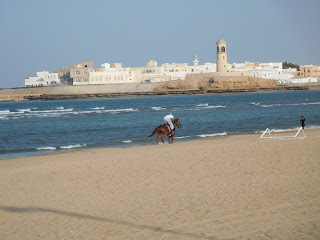Ooh la la, exclaimed our driver as we hurtled down the dusty street, weaving between the cars, bikes, trucks, buses and the odd camel like a dodgem. La la’s tuk-tuk was always parked outside our hotel waiting, always waiting. Business was slack as canny tourists were using Uber. It was cheaper with no haggling about fares. With his long white hair and toothless grin one could be forgiven for thinking his driving days were almost over.
So that first morning he looked so happy at the prospect of customers. Ushering us into his ancient tuk-tuk he confidently turned the ignition key - to no effect. He laughed and tried again. Nothing. He got out and rummaged in the back, waved a piece of old rope in the air and, smiling at our concerned expressions, enlisted another driver’s help. After a few tugs of the rope, the engine sprang to life and he hopped inside. We were off. Driving in India is a skill to behold. Basically you aim your vehicle in the desired direction and sound your horn at whatever gets in your way. Since everyone blasts their horns all the time I’m not sure why it works, but it does. Well most of the time anyway. The only rule of the road is that bigger vehicles go first and since tuk-tuk’s are very small they are far down the pecking order, but this didn’t put La-La off – he acted as if he were driving a truck! We soon realised where he got his name as each time a car came too close or we bounced over a bone shaking hole, La La would utter, ‘Ooh la la,’ in a passably good French accent. Wherever we wanted to go it always cost 100 rupees and his tuk-tuk would never start without the ‘rope’ technique. With La La at the helm the trips were always fun and exhilarating.
 |
| La La |
We spent almost three weeks exploring Rajasthan, starting and ending in Jaipur and staying, along the way, in Bundi, Pushkar, Jodhpur and Jaisalmer. We visited unforgettable monuments, including the extraordinary Hawa Mahal in Jaipur, which the Maharajah built for his nine wives in the late 1700s so they could look down on the town without being seen; the atmospheric palace at Bundi; Jodhpur’s magnificent fort and restored stepwell and the magical, if very touristy, fort of Jaisalmer. But the most enduring memories will be of the people that we encountered along the way.
 |
| Jaipur traffic seen from the Hawa Mahal |
In the days before we met La La we hired a car to take us around Jaipur. One sunny Sunday afternoon my eyes were drawn to a splash of colour on the grimy pavement. A smiling woman was cradling a man’s head, oblivious to the traffic hurtling by. For a moment I thought he was ill and then I saw her hands smoothing his hair and realised she was giving him a head massage. Around her was dirt and diesel fumes, but the yellows and reds of her sari were vibrant and clean. A small girl, in an old jumper and ragged skirt joined them, jumping over her father and laughing as he tried to grab her bare feet. She clutched a fat orange in her hands. He reached for it, but she snatched it away, triumphant as she started peeling the skin with grubby fingers. A boy joined her and they shared the juicy segments. Was this busy road junction home? A pane of glass between you and the outside world allows you to observe, un-noticed.
 |
| So many colours! |












































